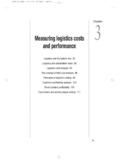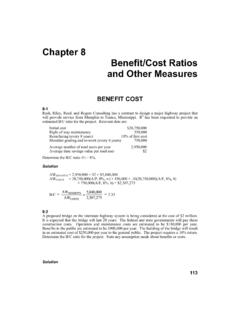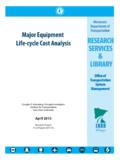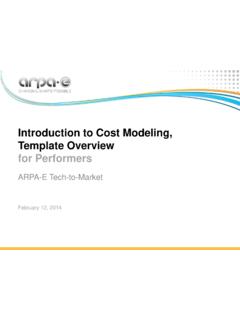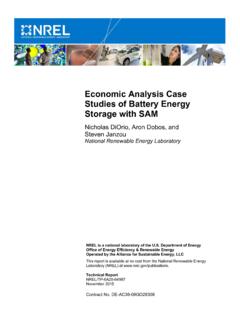Transcription of CAPITAL BUDGETING - Texas Southern University
1 CAPITAL BUDGETING What is CAPITAL BUDGETING ? Long-term decisions, typically involve longer time horizons, cost larger sums of money, and require a lot more information to be collected as part of their analysis, than short-term decisions. The investment of funds into CAPITAL or productive assets, which is what CAPITAL BUDGETING entails, meets all three of the above criteria and therefore is considered a long-term decision. The efficacy of CAPITAL BUDGETING decisions can have long-term effects on a firm and are thus to be made with considerable thought and care. Three keys things to remember about CAPITAL BUDGETING decisions include: 1. A CAPITAL BUDGETING decision is typically a go or no-go decision on a product, service, facility, or activity of the firm. That is, we either accept the business proposal or we reject it. 2. A CAPITAL BUDGETING decision will require sound estimates of the timing and amount of cash flow for the proposal. 3. The CAPITAL BUDGETING model has a predetermined accept or reject criterion.
2 payback Period This method simply tries to determine the length of time in which an investment pays back its original cost . If the payback period is less than or equal to the cutoff period, the investment would be acceptable and vice-versa. Thus, its main focus is on cost recovery or liquidity. The payback period method has three major flaws: 1. It ignores all cash flow after the initial cash outflow has been recovered. 2. It ignores the time value of money. 3. It does not take into account the risk of the cash flows. Net Present Value (NPV) The NPV method is applied by discounting all the cash flows from a project back to time 0 using an appropriate discount rate. A positive NPV implies that the project is adding value to the firm s bottom line and therefore when comparing projects, the higher the NPV the better. Internal Rate of Return The Internal Rate of Return (IRR) is the discount rate which forces the sum of all the discounted cash flows from a project to equal 0.
3 The decision rule that would be applied is as follows: If the project s IRR is higher than the discount or hurdle rate or cost of CAPITAL , it would essentially mean that its NPV would be greater than zero as well. The IRR is measured as a percent while the NPV is measured in dollars. Appropriate Discount Rate or Hurdle Rate: A project s discount rate or hurdle rate is the minimum acceptable rate of return that an investor or firm should earn on a project given its riskiness. For a firm, it would typically be its weighted average cost of CAPITAL (WACC) Problems with the Internal Rate of Return: In most cases, the NPV criterion and the IRR approach lead to consistent decisions. That is, if a project has a positive NPV, its IRR will exceed its hurdle rate, making it acceptable. Similarly, the highest NPV project will also generally have the highest IRR. However, there are some cases when the IRR method leads to ambiguous decisions or is problematic.
4 In particular, we can have 2 problems with the IRR approach: 1. Multiple IRRs; and 2. An unrealistic reinvestment rate assumption. Overview of CAPITAL BUDGETING methods The following observations can be made: 1. payback period is simple and fast, but economically unsound. It ignores all cash flow after the cutoff date, it ignores the time value of money, and it does not account for risk. 2. Discounted payback period incorporates the time value of money but still ignores cash flow after the cutoff date. 3. Net present value (NPV) is economically sound and properly ranks projects across various sizes, time horizons, and levels of risk, without exception for all independent projects. 4. Internal rate of return (IRR) provides a single measure (return), but has the potential for errors in ranking projects. It can also lead to an incorrect selection when there are two mutually exclusive projects or incorrect acceptance or rejection of a project with more than a single IRR.
5 Questions 1. How does a business determine whether a project (new product or service) is worthwhile? Projects are accepted or rejected based on the use of one of many CAPITAL BUDGETING models. Using the cash flow of a project and a model such as Net Present Value or Internal rate of Return, the business can determine if the project is worthwhile. 1. What is the difference between a short-term decision and a long-term decision? The obvious answer is time frame that the decision affects. In general, short-term decisions have a shorter length of impact, lower cost , and require less information for a decision compared with a long-term decision. 2. What question is the payback period model answering? What are the two major drawbacks of the payback period? In what situations do businesses still use it? payback period answers the question, how soon will I recover my initial investment (money)? The two major drawbacks are, it ignores all cash flow after the initial cash flow is recovered and it ignores the time value of money.
6 Many companies use payback for small dollar decisions. 3. What drawback of discounted payback period does the net present value overcome? The Net Present Value model overcomes the problem of ignoring all cash flow after the initial cash flow has been recovered. NPV uses all the discounted cash flows of the project. 4. Why is it straightforward to compare one project s NPV with that of another project s NPV? Why does ranking projects based on the greatest to least NPV make sound financial sense? The final answer for the NPV model is the projects value in current dollars. So we can compare to projects by simply looking at the one with the larger value in current dollars. The greater the NPV of a project the greater the bag of money for doing the project so projects can be ranked from most desirable to least desirable. 5. Why do different projects have different discount rates in the NPV model? Each project has a different level of risk (based on the riskiness of the future cash flows of the project) so each project in the NPV model should receive an appropriate discount rate that is consistent with the level of risk.
7 6. When does the internal rate of return model give an inappropriate decision when comparing two mutually exclusive projects? With two mutually exclusive projects it is possible to select the one with the lowest net present value by selecting the project with the highest IRR. When two projects have fairly different outflows and timing of inflows, their NPV profiles cross-over at some point called the cross-over rate. Below this rate, the project with the lower IRR has the higher NPV and vice-versa. So, selecting the project with the higher IRR would result in accepting a lower NPV, which is sub-optimal.



